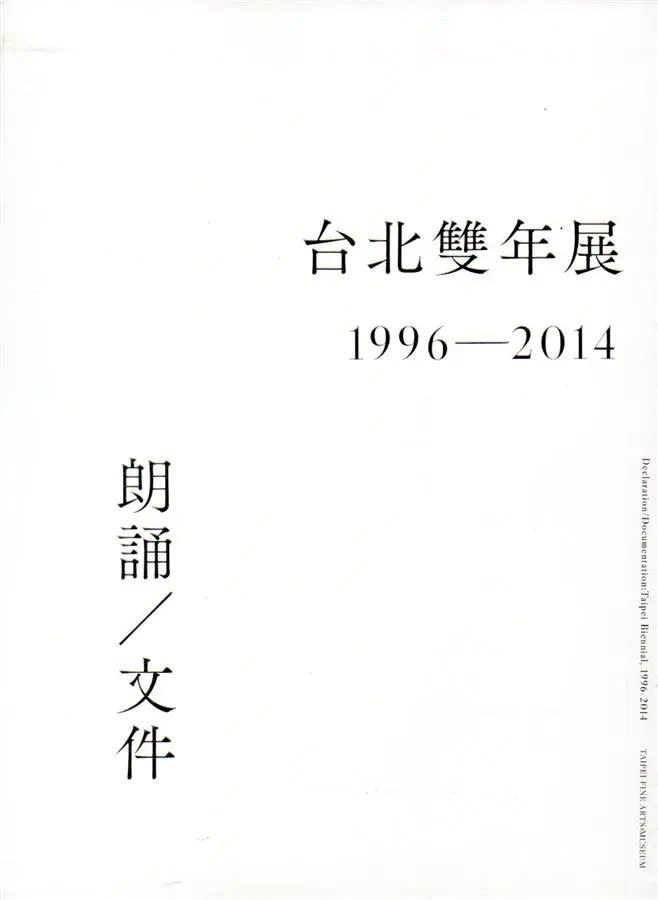Held once every two years, the Taipei Biennial is Taipei Fine Arts Museum’s premier international exhibition exploring the confluence between Taiwanese and international contemporary art. This year, we celebrate the Taipei Biennial’s 20th anniversary. Now, as we commemorate two full decades of the Taipei Biennial, TFAM presents the special exhibition “Declaration / Documentation: Taipei Biennial, 1996-2014.” By producing an archive, presenting exhibits and hosting a series of forums, we recollect and cast a new gaze upon the evolution of the Taipei Biennial. And as we turn around to look back, we hope to find the coordinates and perspectives to solve new problems and achieve new creations.
The word “Declaration” in the exhibition title reflects our aspiration to unveil the voices, articulations, expressions, gestures and poses of past curators and artists as they responded to the contemporary world and everyday life through their exhibitions and artworks within the halls of the Taipei Fine Arts Museum. Based on extant documentation, the exhibition is organized in three parts – archives, exhibits and panel discussions.
The framework of the archive takes the form of a website – an extension of the Taipei Biennial in a virtual space. It spans all ten previous Biennials, from 1996 to 2014, including curatorial statements, artists’ works and projects, online exhibitions, reports and reviews, a timeline, data graphics, as well as texts, photographs, manuscripts and audiovisual recordings, all available to the public to access and study.
Over the past 20 years, some of the artists completed their works by changing the positions of their own bodies, pursuing site-specific themes from the vantage points of different cultural backgrounds, exploring, studying, blending into and coming to understand this locality, even inviting visitors to participate. Consequently, the exhibition gallery not only displays physical artifacts such as posters, brochures and artists’ project manuscripts, but also exhibits themes and events centered on site-specificity, including works created on premises specially for Taipei Biennials of the past. For example, at the 2000 Taipei Biennial, the Austrian artist Erwin Wurm made a documentary of his “One Minute Sculptures” in Taiwan, and in 2012 the Danish artist Virlani Hallberg engaged in a field survey and interviews to produce the video “Receding Triangular Square.” Other art projects began at a Taipei Biennial but continued after it had finished. For example, Jin-Hua Shi’s “Auction” and “X Trees” and Pak Sheung Chuen’s “Going Home” from the 2010 Biennial were extended to Beijing. Finally, we have specially invited Yu Cheng-Ta and Chou Yu-Cheng, both Taipei Biennial alumni artists, to create new works integrating sound and text, which resonate with elements from past Biennials.
Our hope is to encourage people to remember and reconsider archives of the past that seem to have fallen still, or have even been forgotten, to ponder them and talk about them again, and breathe new life into them. To this end, we have organized a series of forums, divided into two segments. The first features international curators of previous Taipei Biennials, returning to TFAM to field queries from curatorial studies scholar Lu Pei-Yi and to engage in dialogue with Taiwanese curators and art professionals, exchanging insights and experiences. The second portion is a “Biennalathon” curated by senior international curator Manray Hsu – a series of marathon art discussions among a wide variety of art professionals, pondering how Taiwanese art has changed over the last 20 years in such aspects as creative methods, the art ecosystem, institutions and policies, and international exchanges. All events will be recorded audiovisually, becoming documentary products of the Taipei Biennial in their own right. Based on the curatorial concept of exploring new ways to remember, read, perceive and revitalize archives of previous Biennials, the exhibition aims to achieve a more complete feeling, comprehension and vantage point on Taipei Biennials of the past, and even the future.
-
 Shi Jin-Hua1964-2024X Bodhi Trees, 2010-2021Trees, basalt, canvas, cement paint, digital photograph, pencil on paper, documentation42 x 29.7 cm (Artist Statement),
Shi Jin-Hua1964-2024X Bodhi Trees, 2010-2021Trees, basalt, canvas, cement paint, digital photograph, pencil on paper, documentation42 x 29.7 cm (Artist Statement),
166.5 x 235 x 4 cm x 2 pcs (Counting Canvas) ,
130 x 52 cm x 12 pcs (Documentation)
35 x 23.5 x 3.8 cm x 30pcs (Wooden board),
97 x 23 x 14 cm x 2 pcs (shovels) ,
15.5 x 10.5 cm x 250 pcs (Prayers) ,
10.2 x 15.2 cm x 25 pcs (Process images) ,
27.9 x 21 cm x 12 pcs (six letters),
14 x 17.25 cm (bankbook of the replant events)
42 x 29.7 cm x 3 pcs (Tree Planting List of the replant events). -
 Shi Jin-Hua1964-2024Contemporary Art Alchemy, Part IV - Taipei Biennial Exhibition Space for Auction, 2010Digital photograph, document55 x 189.8 cm,
Shi Jin-Hua1964-2024Contemporary Art Alchemy, Part IV - Taipei Biennial Exhibition Space for Auction, 2010Digital photograph, document55 x 189.8 cm,
42 x 29.7 cm







